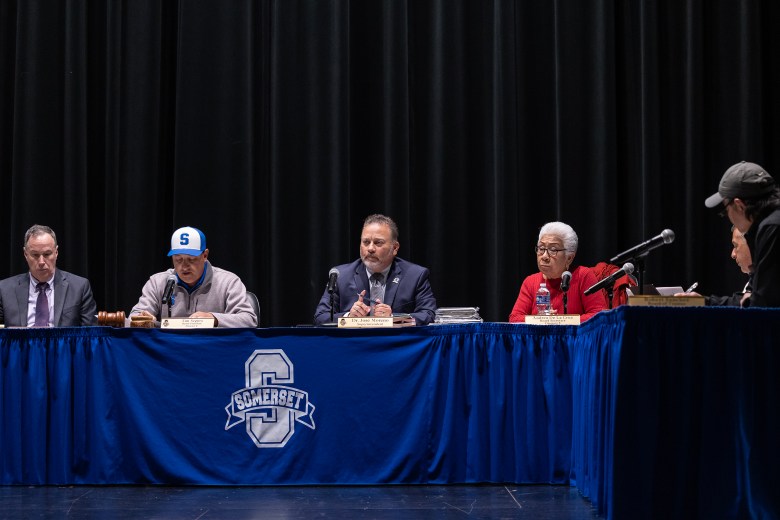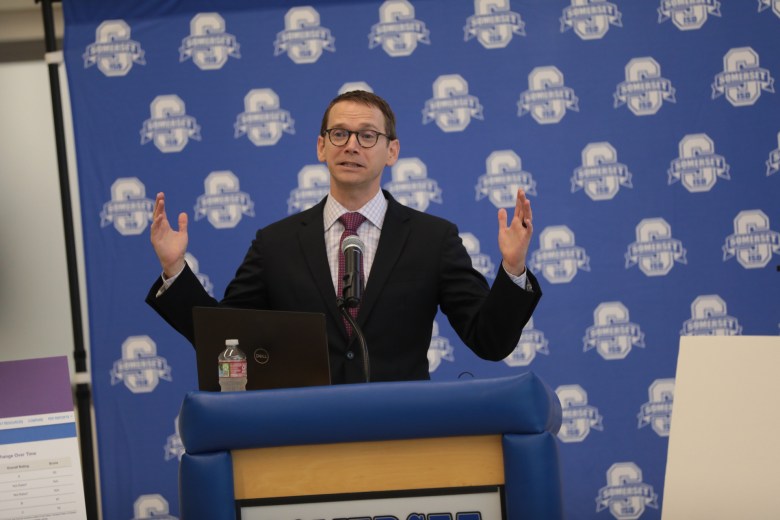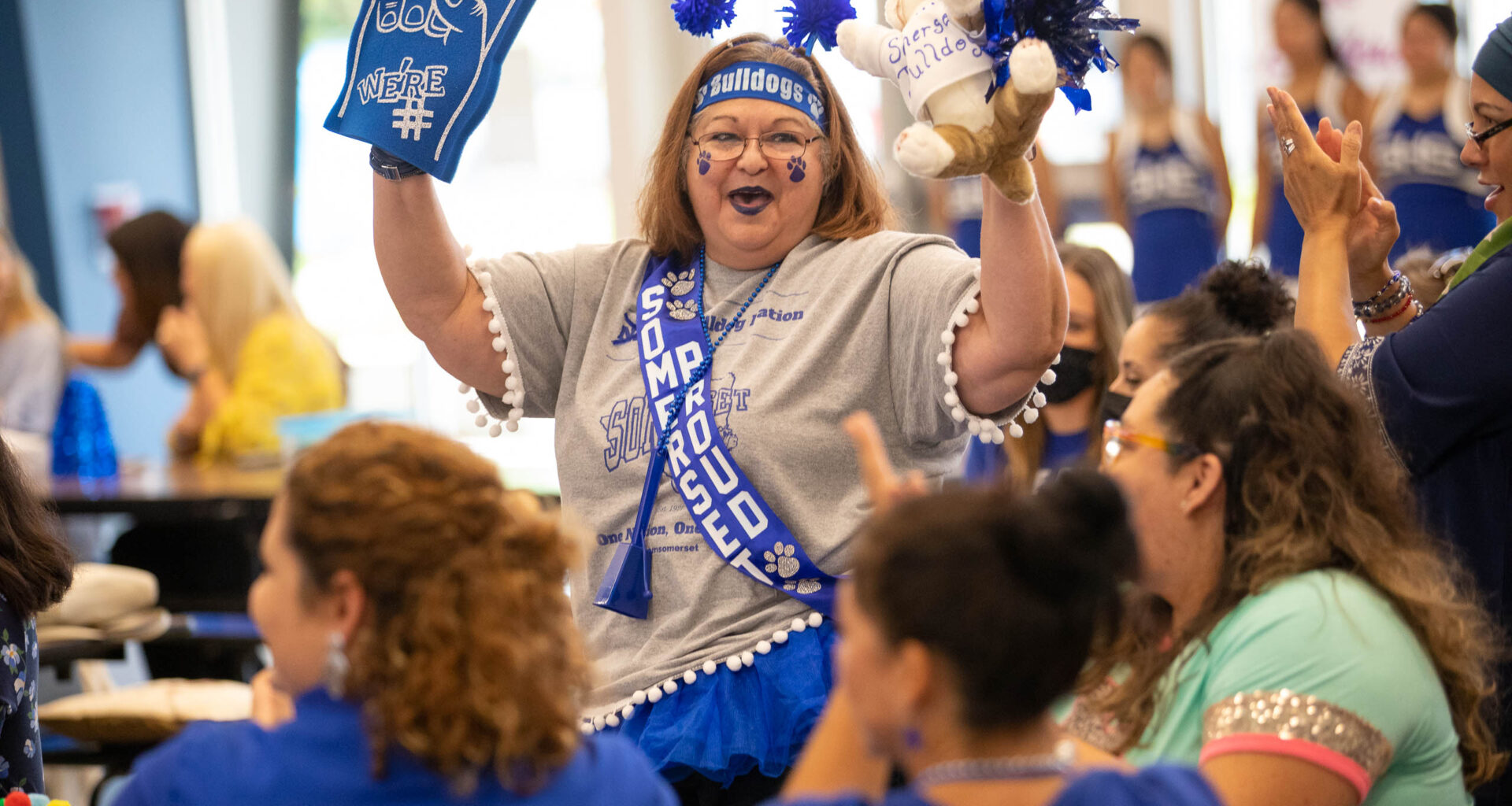Located on the far South Side, right outside San Antonio city limits and Loop 1604, Somerset Independent School District is one of a handful of school districts in the country to academically recover from the 2020 pandemic.
Modestly sized with an enrollment of 4,145 students, Somerset ISD has eight schools, including Somerset Junior High, one of the highest-performing schools in Bexar County.
More than 86% of students across the district are considered economically disadvantaged, meaning they qualify for free or reduced lunch. At the junior high, the number is only slightly lower, at nearly 85%.
To Roni Gonzales, who’s served as Somerset Junior High principal for five years and has been with the district since 2005, it’s all about looking at the data and building a student’s confidence.
“We’re always looking at growth — we’re daily looking at data and adjusting as we go,” Gonzales said. “Our whole concept, especially around a middle school student, is building confidence. … Even if it’s dance or mariachi, we bring confidence out in kids to perform, which they can then take into an algebra class or history class.”
In the latest round of state accountability ratings released for the 2022-23 school year, the junior high received an A rating, while the school district scored a B.
While the 2023-24 ratings are held up in state courts and the 2024-25 ratings are on track to be released in August by the Texas Education Agency, there are more recent benchmarks reflecting Somerset ISD’s effectiveness.
The Education Recovery Scorecard, a project that measures changes in student achievement, listed Somerset ISD as one of about 100 school districts in the country that’s performing above pre-pandemic levels in both math and reading in their 2024 report.
 Somerset High School faces Wimberley High School at a 2020 football game. Credit: Scott Ball / San Antonio Report
Somerset High School faces Wimberley High School at a 2020 football game. Credit: Scott Ball / San Antonio Report
Released in February, the report compares school districts’ performance to national averages from the National Assessment of Educational Progress, detailing recovery efforts in a post-COVID world. The report found that the average U.S. student remains half a grade level behind in math and reading, and wealthier districts are nearly four times more likely than poorer districts to academically recover.
“Still, we see examples of higher-poverty districts recovering in reading and math,” the report says.
Measuring performance
State of Texas Assessment of Academic Readiness (STAAR) scores for the spring of 2025 released this month show Somerset ISD students outperforming most school districts in the San Antonio area.
In Algebra I, a test taken by nearly all eighth-graders at Somerset Junior High, about 70% of students scored on grade level or higher across the district. Across Texas, fewer than half of students scored on grade level.
This year’s results mark a 12 percentage point increase compared to 2019 Algebra I scores for the junior high and an overall eight point improvement for the district.
Despite seeing small gains each school year, none of the big three school districts in San Antonio — Northside ISD, North East ISD and San Antonio ISD — have gotten back to pre-COVID levels on the Algebra I STAAR. The number of students who met grade level this year in those districts fell between 12% and 22% compared to 2019.
 The Somerset ISD board of trustees meets inside of the Somerset High School Performing Arts Center in 2023. Credit: Bria Woods / San Antonio Report
The Somerset ISD board of trustees meets inside of the Somerset High School Performing Arts Center in 2023. Credit: Bria Woods / San Antonio Report
Gonzales credits her school’s substantial improvement in math to a locally designed curriculum designed by Somerset Junior High teachers that tailors lessons based on students’ individual needs.
The school has no “honors” classes, meaning students performing at different levels often work and learn together, allowing for stronger students to help struggling students.
“They’re learning from each other. They’re sharing ideas with each other. They share their strategies,” Gonzales said.
Teachers also individualize instruction for students based on past STAAR performance, Gonzales added, meaning the same lesson may be presented differently for a student who “approached” grade level in their performance, compared to a student who met or mastered grade level content.
“We know all students by name and need,” she explained.
Writing their own curriculums
Wesley Thompson is the executive master teacher at Somerset Junior High for seventh grade math and Algebra I, and part of his job is helping other teachers write their own curriculums and lesson plans to meet specific student needs.
“A state curriculum is one-size-fits-all, and when I first started teaching that size wasn’t fitting our kids very well,” Thompson said.
His focus at the school has been differentiating between different levels of learners and creating detailed “profiles” for kids, a change the school implemented in 2019.
Since then, the campus and school district went from a B to an A rating for the 2021-22 school year resulting in a visit from Texas Education Commissioner Mike Morath where he called the gains seen at Somerset ISD as “nothing short of extraordinary.”
Looking at the school’s daily performance data, Thompson, who’s been with Somerset ISD for 10 years, said he’s learned that struggling students need to be taught in the same classroom as students who mastered their grade level on STAAR exams.
 Texas Education Agency Commissioner Mike Morath visits Somerset ISD in 2022 after it was announced the Southside district earned an A in state accountability ratings on academic achievement. Credit: Scott Ball / San Antonio Report
Texas Education Agency Commissioner Mike Morath visits Somerset ISD in 2022 after it was announced the Southside district earned an A in state accountability ratings on academic achievement. Credit: Scott Ball / San Antonio Report
Thompson laid out an example of how differentiated instruction might work in a seventh-grade classroom: while a master student might be asked to calculate an 8.25% sales tax, a student who meets grade level would be asked to calculate 8%, and an “approaches” grade level student would be asked to calculate 10%.
“The problem for lower-performing kids is that they’re usually in intervention classes surrounded by other struggling kids,” Thompson said. “Being in a group with higher-level students and just seeing and hearing the way they think and how they approach math and how they approach being a student, really benefits our struggling learner.”
Beyond academics, Thompson and his boss, Gonzales, credit the campus culture and the district’s wraparound services in fostering student growth.
Currently, the school has 15 teachers that qualify for the Teacher Incentive Allotment, a system that rewards eligible teachers’ “effectiveness” in the classroom with yearly stipends that range from $3,000 to $32,000 depending on a teacher’s skill and their campus needs.
“I have a very low turnover rate,” Gonzales told the Report. “I attribute that to our district beliefs, the campus that we have and the way we take care of students and teachers.”
The district partners with the nonprofit Communities in Schools of San Antonio and has a Thrive Center, opened in 2021, where Somerset ISD students, staff and community members can go for mental health and emotional support services. Students at any district campus can be referred to the center by their campus counselor.
Thompson said the combination of having a supportive administration, CIS and the Thrive Center creates an environment where students can learn while having outlets for the emotional needs they can’t tell teachers or peers about.
“We have probably a handful of kids every year that really require those types of support,” he said.
